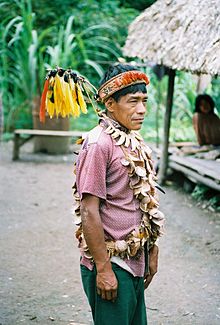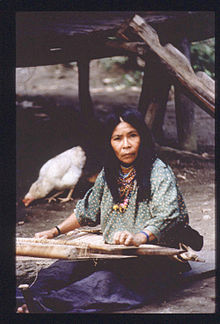
The Urarina are an indigenous people of the Peruvian Amazon Basin (Loreto) who inhabit the valleys of the Chambira, Urituyacu, and Corrientes Rivers. According to both archaeological and historical sources, they have resided in the Chambira Basin of contemporary northeastern Peru for centuries. The Urarina refer to themselves as Kachá (lit. "person"), while ethnologists know them by the ethnonym Urarina.
The local vernacular term for the Urarina is Shimaku, which is considered by the Urarina to be pejorative, as it is a Quechua term meaning "unreliable". The ethnonym "Urarina" may be from Quechua--uray meaning below, and rina referring to runa, or people. Urarina is rendered in Quechua as uray-runa or people from below or down stream people.
Society and culture
Urarina society and culture have been given little attention in the burgeoning ethnographic literature of the region, and only sporadic references in the encyclopedic genre of Peruvian Amazonia. Accounts of the Urarina peoples are limited to the data reported by Castillo, by the German ethnologist G. Tessmann in his Die Indianer Nordost-Peru, and to the observations of missionaries and contemporary adventure seekers.
The Urarina are a semi-mobile hunting and horticultural society whose population is estimated to be around 2,000. Urarina settlements are composed of multiple longhouse groups, located on high ground (restingas) or embankments along the flood-free margins of the Chambira Basin's many rivers and streams. The embankments are bounded by low-lying territories (tahuampa and bajiales) that are susceptible to flooding during the annual rainy season (roughly November–May).
Urarina local politics are characterized by a mercurial balance of power between demes united through affinal ties and episodic political alliances, exchange relations, and disputation. Surrounded by the Jivaroan, and the Tupi–Guarani-speaking Cocama-Cocamilla indigenous peoples of the upper Amazon, the Urarina have an elaborate animistic cosmological system. It is based on ayahuasca shamanism, which is based in part on the profoundly ritualized consumption of Brugmansia suaveolens.
The Urarina customarily practice brideservice, uxorilocal patterns of post-nuptial residence, debt peonage and sororal polygyny. While men are esteemed for their hunting prowess and shamanic skills, Urarina women are likewise recognized for their craftsmanship: the women are consummate producers of woven palm-fiber bast mats, hammocks, and net-bags.

Language
Documentation of the Urarina language, which has been classified as a language isolate or unclassified language by Terrence Kaufman (1990) is now under-way. Linguistic work among the Urarina was first pioneered by SIL International.
Mythology
The Urarina have a deluge-myth, in which a man saved himself from the deluge while climbing a cudí (amasiza, Erythrina elei) tree; the man's wife was transformed into a termites' nest clinging to that tree, while their two sons became birds. Afterwards that man acquired a wife, a different woman, one who had at first summoned successively a pit viper, a spider, and a giant biting ant in an unsuccessful attempt to evade him. In another Urarina deluge-myth, a deluge was produced, on the occasion of a cassava-beer festival, by the urination by the daughter of the ayahuasca-god, "giving rise to the chthonic world of spirits".
The Urarina continue to tell elaborate myths and stories about the violence that they experience from outsiders, which historically has included forced-labor conscription, rape, disease, concubinage, and abusive treatment at the hands of outsiders. Portions of the Bible were first published in Urarina in 1973; however, the complete Bible is not published.
Survival
Despite challenges to their ongoing cultural survival, including ecocide, inadequate health-care, and cultural appropriation, the Urarina have both been inspired by and resisted the violence of the colonial and postcolonial encounters in Amazonia, particularly during the Alberto Fujimori regime.
Indigenous rights
Contemporary indigenous resistance has involved intercultural education projects, as well as Urarina political mobilization.
See also
- Universal Declaration of Human Rights, (incomplete) Urarina version from the Coordinadora Nacional de Derechos Humanos
Notes
- Dean, Bartholomew 2009 Urarina Society, Cosmology, and History in Peruvian Amazonia, Gainesville: University Press of Florida ISBN 978-0-8130-3378-5
- (in Spanish) Myers, Thomas P. and Bartholomew Dean “Cerámica prehispánica del río Chambira, Loreto.” Amazonía peruana, 1999 Lima, Published by the Centro Amazónico de Antropología y Aplicacíon Práctica. 13(26):255-288
- (in Spanish) Spanish wiki entry for Shimaku
- Payne, Thomas E. (1997). Describing morphosyntax: A guide for field linguists. Cambridge: Cambridge University Press. p. 13. ISBN 9780521588058.
- For more information, see Paz Soldan 1877:964; Espinoza Galarza 1979:305). Native inhabitants of the Chambira Basin have also been called various names, including: Itukales; Ytucalis, Singacuchuscas; Cingacuchuscas; Aracuies; Aracuyes; Chimacus; and Chambiras (Grohs 1974:53 fn. 4; Velasco 1960: 267; Jouanen 1943, II: 471-2; Figueroa 1904: 163, 177)
- Castillo, 1958, 1961
- Tassmann, 1930, partial Spanish translation 1987
- Dr Knut Olawsky's photos Archived 2007-09-29 at the Wayback Machine, (in Spanish) Peruecologico's Urarina factsheet
- Dean, Bartholomew. "The Poetics of Creation: Urarina Cosmology and Historical Consciousness." Latin American Indian Literatures Journal 1994 10:22-45
- Dean, Bartholomew. "Forbidden fruit: Infidelity, affinity and brideservice among the Urarina of Peruvian Amazonia," Journal of the Royal Anthropological Institute March 1995, Vol. 1 Issue 1, p87, 24p
- Hirschfeld Archive for Sexology, citing Dean 1995
- Dean, Bartholomew. “Urarina Society, Cosmology, and History in Peruvian Amazonia,” Gainesville: University Press of Florida 2009, ISBN 978-0-8130-3378-5
- Dean, Bartholomew. "Multiple Regimes of Value: Unequal Exchange and the Circulation of Urarina Palm-Fiber Wealth," Museum Anthropology February 1994, Vol. 18, No. 1, pp. 3-20 available online (paid subscription)
- "Múltiples regímenes de valor: intercambio desigual y la circulación de bienes intercambiables de fibra de palmera entre los Urarina," Amazonía peruana, Special edition: "Identidad y cultura", Lima, Published by the Centro Amazónico de Antropología y Aplicacíon Práctica. 1995, p. 75-118
- Urarina at Ethnologue (25th ed., 2022)

- Classification of indigenous languages of the Americas#Kaufman (1990) accessed 9 July 2006
- Olawsky, Knut (La Trobe University). "Urarina – Evidence for OVS Constituent Order." Leiden Papers in Linguistics 2.2, 43-68. available online accessed 5 July 2006]
- Manus, Ronald and Phyllis Manus. Text and Concordance of words in Urarina Datos Etno-Lingüísticos 65 series, SIL; 1979 available online accessed 5 July 2006.
- Dean 1994, p. 26
- Dean 1994, p. 27
- Dean 1994, p. 31
- In Anderson, Myrdene (ed.) Cultural Shaping of Violence: Victimization, Escalation, Response. Purdue University Press;2004 ISBN 1-55753-373-3 Chapter 21 reviewed online accessed 5 July 2006
- (in Spanish) Dean, Bartholomew."Intercambios ambivalentes en la amazonía: formación discursiva y la violencia del patronazgo." Anthropológica. 1999, (17):85-115
- Worldscriptures.org online Urarina data accessed 5 July 2006
- Untitled
- Bartholomew Dean et al., 2000 “The Amazonian Peoples’ Resources Initiative: Promoting Reproductive Rights and Community Development in the Peruvian Amazon.” Health and Human Rights: An International Journal Special Focus: Reproductive and Sexual Rights François-Xavier Center for Health and Human Rights at Harvard University’s School of Public Health, Vol. 4, No. 2,
- "Health & Human Rights". www.hsph.harvard.edu. 4 (2). 2000. Archived from the original on 2001-03-03. Retrieved 11 April 2023.
- Bartholomew Dean 2004 “digital vibes & radio waves in indigenous Peru” in Indigenous Intellectual Property Rights: Legal Obstacles and Innovative Solutions. (ed.) Mary Riley, Contemporary Native American Communities Series, 27-53 New York: Altamira Press, A Division of Rowman & Littlefield Publishers. accessed July 9, 2006
- Dean, Bartholomew. "State Power and Indigenous Peoples in Peruvian Amazonia: A Lost Decade, 1990-2000." In The Politics of Ethnicity Indigenous Peoples in Latin American States. Chapter 7, David Maybury-Lewis (ed.) Harvard University Press
- Foundation for Endangered Languages Cultural Survival's "SPECIAL PROJECTS UPDATE: Amazonian People's Resources Initiative; Building Partnerships in Health, Education, and Social Justice October 31, 1997," Cultural Survival Quarterly, Issue 21.3 and IK Monitor 3(3)Research.
- Dean, Bartholomew. "Language, Culture & Power: Intercultural Bilingual Education among the Urarina of Peruvian Amazonia," Practicing Anthropology Special Issue: Reversing Language Shift in Indigenous America, Published by the Society for Applied Anthropology. 1999, 20(2):39-43. See online cite, Education Resources Information Center (ERIC), sponsored by the Institute of Education Sciences (IES) of the U.S. Department of Education
- Dean, Bartholomew and Jerome M. Levi, Eds At the Risk of Being Heard; Identity, Indigenous Rights, and Postcolonial States University of Michigan Press;2003 ISBN 0-472-09736-9 (Chapter 7: Dean, Bartholomew. At the Margins of Power: Gender Hierarchy and the Politics of Ethnic Mobilization among the Urarina)
- Jackson, Jean E and Kay B.Warren. "Indigenous Movements in Latin America, 1992-2004: Controversies, Ironies, New Directions." Annual Review of Anthropology 2005, Vol. 34 Issue 1, p549-573, 25p (http://arjournals.annualreviews.org/doi/abs/10.1146/annurev.anthro.34.081804.120529 Brief online review and paid full access)
References
Bartholomew Dean : "The Poetics of Creation : Urarina Cosmogony and Historical Consciousness". In :- LATIN AMERICAN INDIAN LITERATURES JOURNAL, Vol. 10 (1994)
External links
- Defensoría del Pueblo, Peru
- Language Museum
- DGH in the Peruvian Amazons by Jonathan Harris
| Indigenous |
| ||||||
|---|---|---|---|---|---|---|---|
| Non-indigenous |
| ||||||
| Category:Ethnic groups in Peru | |||||||